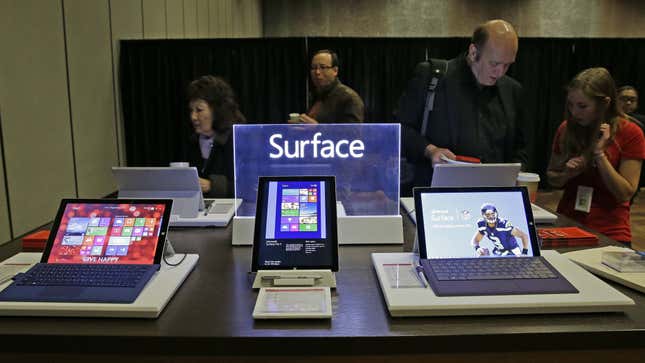Microsoft’s hardware has long been a source of minor profit and major pain. In this last 2014 Monday Note, we’ll look at the roles Microsoft’s hardware devices will play—or not—in the company’s future.
Excluding keyboards and the occasional Philippe Starck mouse, Microsoft makes three kinds of hardware: Game consoles, PC-tablet hybrids, and smartphones. We’ll start with the oldest and least problematic category: Game consoles.
Building on the success of DOS and its suite of business applications, Microsoft brought forth the MSX reference platform in 1983. This was a Bill Gates-directed strategic move; he didn’t want to leave the low-end of the market “unguarded.” Marketed as home computers, which meant less capable than a serious PC, MSX-branded machines were manufactured by the likes of Sony and Yamaha. But their only serious impact was in gaming.
For the next two decades, gaming remained a hobby for Microsoft. This changed in 2001 when the company took the matter into its own hands and built the Xbox. Again, the company wanted to guard against “home invasions.”
With its Intel processors and customized version of Windows, the first iteration of the Xbox was little more than a repackaged PC. The 2005 Xbox 360 was a heartier offering: It featured an IBM-designed Power-PC derivative processor and what some call a “second-order derivative” of Windows 2000 ported to the new CPU.
Now we have the Xbox One. Launched in 2013, the platform is supported by a full-fledged ecosystem of apps, media store, and controllers such as the remarkable Kinect motion sensor.
Success hasn’t been easy. The first Xbox sold in modest numbers, 24 million units in about five years. Sales of the second-generation Xbox 360 were better—almost 80 million through 2013—but it was plagued with hardware problems, colloquially known as the Red Ring of Death. Estimates of the number of consoles that were afflicted range from 23% to more than 54%. Predictably, poor reliability translated into heavy financial losses, as much as $2 billion annually. Today’s Xbox One fares a little better: It lost only $800 million for the first eight months of its life, selling 11.7 million units in the process.
Microsoft’s latest numbers bundle Xbox game consoles and Surface tablet-PCs into a single Computing & Gaming category that makes up $9.7 billion of the company’s $87 billion in revenue for the 2014 fiscal year. This means Xbox consoles contribute less than 10% of total sales, which is probably why Satya Nadella, Microsoft’s new CEO, has carefully positioned the Xbox as less than central to the company’s business:
“I want us to be comfortable to be proud of Xbox, to give it the air cover of Microsoft, but at the same time not confuse it with our core.”
In other words, the Xbox business can continue…or it could disappear. Either way, it won’t have much effect on Microsoft’s bottom line or its future.
For the moment, and with the assistance of a holiday price cut, Xbox One sales are topping those of the Sony PS4. But that shouldn’t take our attention away from a more important trend: The rise of mobile gaming. Smartphones are gaining in raw computing power, connectivity, display resolution, and, as a result, support from game developers on both Android and iOS platforms. Larger, more-capable game consoles aren’t going away, but their growth is likely to slow down.
Compared to the history of Xbox problems, Nadella’s lukewarm embrace of the product, the ascendency of mobile gaming—the Surface tablet should look pretty good.
It doesn’t.
When then-CEO Steve Ballmer introduced the Surface device in June, 2012, he justified Microsoft’s decision to compete with its own Windows licensees by the need to create a “design point,” a reference for a new type of device that would complement the re-imagined Windows 8.

Two and a half years later, we know two things: Surface tablet sales have been modest (about $2 billion in the 2014 fiscal year ended June 30th), and Windows 8 frustrated so many users that Microsoft decided to re-re-imagine it and will re-introduce it as Windows 10, scheduled to be released in mid-2015.
Microsoft believes its Surface combines the best of the PC with the best of a tablet. While the hybrid form has given rise to some interesting explorations by PC makers, such as the Yoga 3 Pro by Lenovo, many critics—and not just Apple—condemn the hybrid as a compromise, as a neither-nor device that sub-optimizes both its tablet and its PC functions (see the tepid welcome given to the HP Envy).
What would happen if Microsoft stopped making Surface Pro tablets? Not much… perhaps a modest improvement in the company’s profit picture. While the latest quarter of Surface Pro 3 sales appear to have brought a small positive gross margin, Surface devices have cost Microsoft about $1.7 billion over the past two years. Mission accomplished for the “design point.”
We now turn to smartphones.
Under the Ballmer regime, Microsoft acquired Nokia rather than let its one and only real Windows Phone licensee collapse. It was a strategic move: Microsoft was desperate to achieve any sort of significance in the smartphone world after seeing its older Windows Mobile platform trounced by Google’s Android and Apple’s iOS.
In the latest reported quarter (ended September 30th 2014), Windows Phone hardware revenue was $2.6 billion. For perspective, iPhone revenue for the same period was $23.7 billion. Assuming that Apple enjoys about 12% of the world smartphone market, quarterly worldwide revenue for the sector works out to about $200 billion…of which Microsoft gets 1.3%. Perhaps worse, a recent study says that Microsoft’s share of the all-important China smartphone market is “almost non-existent at 0.4%.” (China now has more than twice as many smartphone users—700 million—as the US has people, 319 million.)
Hardware development costs are roughly independent of volume, as is running an OS development organization. But hardware production costs are unfavorably impacted by low volumes. Windows Phones sell less and they cost more to make, putting Microsoft’s smartphone business in a dangerous downward spiral. As analyst Horace Dediu once remarked, the phone market doesn’t forgive failure. Once a phone maker falls into the red, it’s nearly impossible to climb back into the black.
What does all this mean for Microsoft?
Nadella uses the phrase “Mobile First, Cloud First” to express his top-level strategy. It’s a clear and relevant clarion call for the entire organization, and Microsoft seems to do well in the Cloud. But how does the Windows Phone death spiral impact the Mobile First part?
In keeping with its stated strategy, the company came up with Office apps on iOS and Android, causing bewilderment and frustration to Windows Phone loyalists who feel they’d been left behind. Versions of Office on the two leading mobile platforms ensures Microsoft’s presence on most smartphones, so why bother making Windows Phones?
Four and a half years ago, in a Monday Note titled “Science Fiction: Nokia Goes Android,” I fantasized that Nokia ought to drop its many versions of Symbian and adopt Android instead. Nokia insiders objected that embracing a “foreign OS” would cause them to lose control of their destiny. But that’s exactly what happened to them anyway when they jumped into bed with Stephen Elop and, a bit later, with Windows Phone. This started a process that severely damaged phone sales, ending with Microsoft’s acquisition of what was already a captive licensee.
Now the Android question rises again.
Should Microsoft pursue what looks like a manly-but-losing Windows Phone hardware strategy or switch to making and selling Android phones? Or should it drop an expensive smartphone design, manufacturing, and distribution effort altogether, and stay focused on what it does already, Mobile-First, Cloud-First applications?
You can read more of Monday Note’s coverage of technology and media here.
